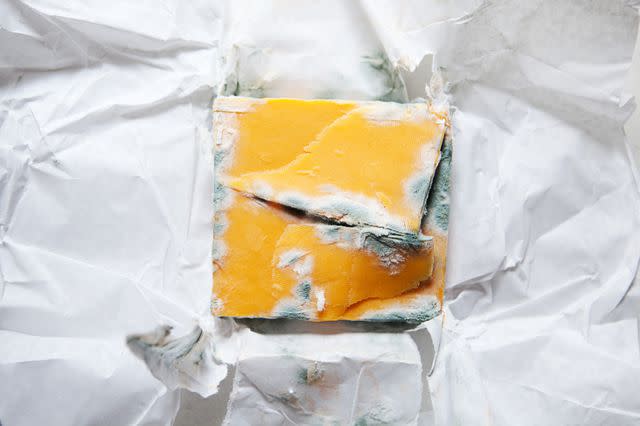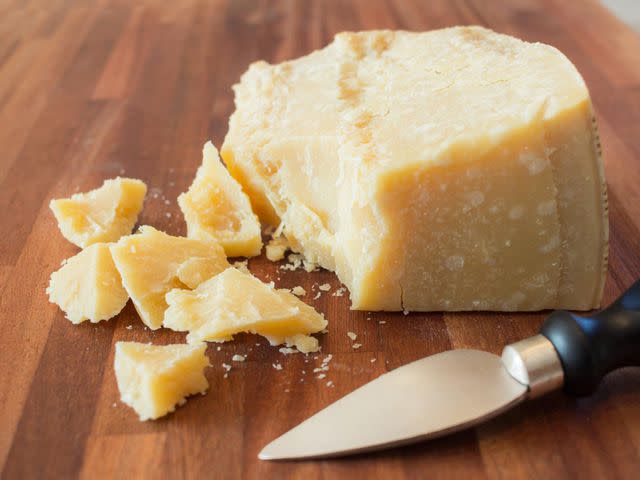This Shockingly Easy Trick Keeps Cheese Fresh 3x Longer
Mold has met its match.
You’re standing at the fridge door, staring down at a block of Cheddar cheese. It's only been a couple of weeks, but there it is—a fuzzy, moldy reminder that you once again bought more cheese than you could eat in time. Sound familiar? Well, it’s time to say goodbye to that sad cheese saga for good.
We’ve stumbled upon a cheese hack so easy and effective, you’ll never believe it can solve all your cheese troubles. It only takes one step (and one pantry ingredient) and it will ensure your cheese stays fresh until you whittle it down to the very last nub.

Why Does Cheese Mold So Quickly?
You might not think of something like cheese having a short shelf life in your fridge (compared to berries, for example), but the spoilage process can happen quicker than you think if you don’t store it correctly.
Being a dairy product, cheese is, unfortunately, a perfect breeding ground for bacteria and mold in the right conditions. In fact, the moment cheese is cut and exposed to air and moisture, the mold clock starts ticking.
Typically, an opened block of cheese can last in your fridge from four to eight weeks (depending on the type, of course). But, with this simple hack, the exact same cheese can stay fresh for up to three times longer. All you need is one ingredient that’s probably already in your pantry.
The Best Storage Hack For Keeping Cheese Fresh
When you’re storing a fresh block of cheese you’ve just removed from the packaging, instead of just tossing it into a zip-top bag and returning it to the fridge, do this essential step first.
Take a clean paper towel, dip it in white vinegar to dampen it (wringing out any excess) and wrap the vinegar-soaked towel completely around the block of cheese. Then you can transfer it to a zip-top bag (or airtight container) and store it in your fridge's cheese drawer.
From there, all you have to do is monitor the dampness of the paper towel every once in awhile, re-wetting it with more vinegar if it dries out. Then you'll have fresh, mold-free cheese to enjoy for weeks and weeks to come.

Mauro69/Getty Images
How Vinegar Helps Preserve Cheese
We know what you’re thinking, and no, this hack won’t leave you with a vinegar-flavored grilled cheese. In fact, what makes this trick so useful is that it doesn’t change the flavor of the cheese at all. The vinegar will simply stop bacteria from growing on the surface so you can enjoy it longer.
The magic is in the white vinegar, which, thanks to a high concentration of acetic acid, has incredible antimicrobial and anti-fungal properties. This means it can be used to significantly slow the growth of microorganisms that spoil food.
It also keeps the cheese at just the right level of humidity. Cheese needs to retain some moisture to preserve its texture and flavor, but too much moisture can accelerate mold growth and spoilage. Using a vinegar-dampened towel provides a moist enough environment to prevent the cheese from drying out, while the acidity of the vinegar prevents it from becoming a breeding ground for mold.
Can You Use the Vinegar Hack on All Cheeses?
The effectiveness of this trick works on a scale depending on what type of cheese you’re trying to preserve. For hard cheeses with a low moisture content (think Parmesan, Pecorino, and aged Cheddar), this trick will work beautifully for months. It will also be a game-changer for semi-hard cheeses like Gouda, Swiss, and provolone.
But, as the cheeses get softer, the storage trick loses its magic. While vinegar can extend the freshness of soft cheeses like Brie, Camembert, and mozzarella, if the towel is too damp with vinegar, it can cause sogginess or texture changes in the cheese. And, in fresh cheeses, it can ruin the flavor and texture entirely, so stick to the hard stuff when you use this technique.
Go ahead—buy your favorite cheeses in bulk and shop fancy cheese sales if you’d like. With this trick, you won’t have to worry about the state of your cheese drawer, and you’ll never see your hard-earned Cheddar grow rotten again.
Read the original article on All Recipes.






